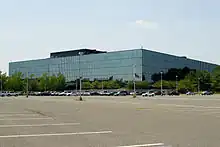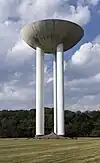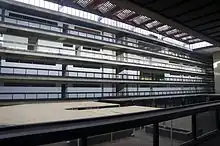Bell Labs Holmdel Complex
The Bell Labs Holmdel Complex, in Holmdel Township, Monmouth County, New Jersey, United States of America, functioned for 44 years as a research and development facility, initially for the Bell System and later Bell Labs.[3] The centerpiece of the campus is an Eero Saarinen–designed structure that served as the home to over 6,000 engineers and researchers.[4] This modernist building, dubbed "The Biggest Mirror Ever" by Architectural Forum, due to its mirror box exterior, was the site of a Nobel Prize discovery, the laser cooling work of Steven Chu.[1][10]
| Bell Works | |
|---|---|
 Aerial view, 2008 | |
| General information | |
| Architectural style | Mid-Century Modern |
| Location | Holmdel Township, New Jersey, U.S. |
| Address | 101 Crawfords Corner Road, Holmdel, New Jersey[1] |
| Coordinates | 40°21′54″N 74°10′2″W |
| Construction started | 1959[2] |
| Completed | 1962[3] |
| Owner | Somerset Development d/b/a Bell Works |
| Technical details | |
| Floor count | 6 |
| Floor area | 2,000,000 square feet (190,000 m2)[4] |
| Grounds | 472.69 acres (1.9129 km2)[5] |
| Design and construction | |
| Architect(s) | Eero Saarinen[6] |
| Other designers | Sasaki, Walker & Associates[7] |
| Awards and prizes | 1967 Laboratory of the year |
| Website | |
| www | |
Bell Laboratories-Holmdel | |
   | |
| NRHP reference No. | 16000223[8] |
| NJRHP No. | 4771[9] |
| Significant dates | |
| Added to NRHP | June 26, 2017 |
| Designated NJRHP | March 8, 2016 |
The building has undergone renovations into a multi-purpose living and working space, dubbed Bell Works by its redevelopers. Since 2013 it has been operated by Somerset Development, who redeveloped the building into a mixed-use office for high-tech startup companies.[11] The complex was listed on the National Register of Historic Places in 2017.[9]
Bell Telephone Laboratories previous use
Before the present building, the site was used by Bell Telephone Laboratories for research. Karl Guthe Jansky invented radio astronomy there, and a monument was placed at the former location (40°21′54.5″N 74°09′48.9″W) of the antenna almost seventy years later in 1998. The monument is a stylized sculpture of the antenna and is oriented as Jansky's antenna was at 7:10 p.m. on September 16, 1932, at a moment of maximum signal caused by alignment with the center of our galaxy in the direction of the constellation Sagittarius.[12][13]
Bell Laboratories building by Saarinen


In 1957, the American Telephone and Telegraph Company (AT&T) began to plan a research laboratory in Holmdel Township in Central New Jersey.[7] Constructed between 1959 and 1962, this complex was one of the final projects of Finnish-American architect Eero Saarinen before his death in 1961.[6] Used as a research and development complex, it served the needs of the Bell Laboratories division of AT&T.[7] Basic research, applied hardware development, and software development occurred in the building.
The building's distinctive features, including its mirror-like appearance, led to recognition as the Laboratory of the Year by R&D in 1967.[14]

The building was expanded in 1966 and 1982 to its final size of two million square feet of office and laboratory space.[15] Despite these expansions, the original curtain wall design remained intact, as did the unique layout of the site, which included a large elliptical master plan and country-road like approach. Over its active life-span, the facility and its layout were studied in universities as models of modernist architecture.[16] Internally, the building was divided into four pavilions of labs and offices, each separated from the others by a cross-shaped atrium. The internal pavilions were linked via sky-bridges and perimeter walkway.[7]
Also of note is the water tower on the complex. The three-legged design reminded people of a transistor – a major achievement of Bell Labs (in 1947 at a different location). Despite a total lack of historical evidence, an urban legend claims that the designer actually intended to memorialize the transistor.[17] Another urban legend – less widely circulated than the transistor story – claims that the concrete floodlight stand at the base of the tower was originally a water fountain.[18] The tower was still in usable condition more than 40 years after its construction.[19]
Alcatel-Lucent closure of site
Bell Labs subsequently became part of Lucent, and then Alcatel-Lucent. In 2006, Alcatel-Lucent contracted to sell the 2 million-square-foot facility to Preferred Real Estate Investments, during the process of restructuring the company's research efforts.[10] Despite initial plans to maintain the original buildings and keep the six-story complex as a corporate office park, Preferred later sought to rezone it as residential property.[15][20][21][22] As a result, the complex was added to The Cultural Landscape Foundation's list of 10 Most Endangered Historic Sites in New Jersey in May 2007.[1] Additionally, action led to the creation of a citizen's group, Preserving Holmdel, by former Bell employees, to lobby for keeping the complex as it was when in use as a laboratory.[23] A report by Preservation New Jersey contemplated changes to the property, including ideas such as a university center, recreational complex, and a healthcare facility.[24]

The transaction with Preferred Real Estate Investments did not close, and on May 17, 2012 Holmdel Township declared the site as an "Area in Need of Redevelopment"[25] and adopted a redevelopment plan for the property that included various adaptive reuses of the main building, the construction of up to 40 single-family homes, and 185 age-restricted townhomes outside the main ring road surrounding the building. The plan was based on a concept proposed by Inspired by Somerset Development (then Somerset Development).[26]
In September 2013, the property was officially purchased by Inspired by Somerset Development – which submitted a concept plan in accordance with Holmdel Township’s redevelopment plan for $27 million.[27] Inspired by Somerset Development proposed an adaptive reuse project that included offices, a health and wellness center, restaurants, shopping, a spa, and a 20,000-square-foot public library. Recreational space and luxury homes were planned for the surrounding land; national homebuilder Toll Brothers was slated to be the residential developer of the project.
Architect Alexander Gorlin served as the master architect for the projects and introduced new designs, which included[28] opening up the laboratory spaces with atrium light by replacing Saarinen's metal panels with glass, redesigning the two mammoth 1,000-by-100-foot atria floors, and replacing skylights with transparent photovoltaic panels. As a result of these design improvements, the building won numerous design and architecture awards, including the Docomomo US Modernism in America Award,[29] Starnet Commercial Flooring Design Award,[30] and the Azure Awards, Architecture Adaptive Re-Use category.[31]
Bell Labs to Bell Works
In 2013, Inspired by Somerset Development officially secured ownership of the Bell Labs site and signed a deal with Toll Brothers to sell 103 acres of land to develop 225 homes on a portion of the property between the main building and Crawfords Corner Road while retaining the entirety of the Eero Saarinen-designed structure (Bacevice et al., 2022). This deal with Toll Brothers helped to provide the capital for Inspired by Somerset Development to pursue its New Urbanism-inspired redevelopment plan at Bell Labs. The plan aimed to transform the site from office-lab to a space that would provide the Holmdel Township community–and other nearby residents–with access to the multitude of benefits traditionally associated with an urban environment (shops, dining, retail, library, offices, etc.) while preserving the structure of an iconic piece of mid-twentieth-century architecture.[32]

Finding that these redevelopment plans satisfied its demands for residential zoning and preservation standards for the property, Holmdel Township officially approved Somerset Development to move forward with the redevelopment of Bell Labs in August 2013[33] The project was a massive undertaking: The lobby was overgrown with plants and the quarter mile-long roof leaked. Ralph Zucker, Chief Executive Officer and Founder of Inspired by Somerset Development, assembled an ambitious team of architects, designers, and marketers for the project. Among the team were Alexander Gorlin Architects, The Garibaldi Group, Co Op Brand Partners, and NPZ Style + Décor.
As the project began to crystallize, the civic relationship between Holmdel Township and Bell Works grew stronger, with then-mayor Eric Hines celebrating early construction milestones and leasing achievements. Mayor Hines went on record several times[34] celebrating the success of the project. Further strengthening the relationship between Bell Works and Holmdel Township was the approval of a 30-year lease agreement between Inspired by Somerset Development and the township in the amount of $0 for housing the Holmdel Township branch of the Monmouth County Library at Bell Works. This represented a significant increase in space for the library, which went from 3,000 square feet to 18,000 square feet.[35]
In July 2015, Bell Works signed its first lease with James Lavin Real Estate, which was set to rent 1,100 square feet[33] In May 2016, WorkWave signed a lease for more than 77,000 square feet, bringing in 185 employees to the space. Local startup iCIMS followed suit and rented 350,000 square feet to account for its expansion from 650 to 2,000 employees. Recognizing the convenience of Bell Works and its ability to inspire, office tenants sought a variety of spaces within the property, including CoLab, a furnished coworking space for meetings, events, and business functions.

Bell Works is often described as a “metroburb” — a phrase coined by Ralph Zucker.[36] According to the Bell Works website, a metroburb is “an urban hub. A little metropolis in suburbia… A large-scale mixed-use building, with great access, office, retail, entertainment, hospitality, residential, health, wellness, fitness, everything you would find in a metropolis but in a great suburban location."[37] Bell Works’ success as a proof of concept for Zucker’s metroburb was supported by its pioneering example of an entirely new workspace typology, one which used the scale of Bell Works to simulate the density of urban cityscapes within the office while providing a degree of flexibility and modularity that is difficult to achieve outside of a suburban environment.[38] As of 2019, more than 90 percent of the campus’ office space was leased—a testament to the success of the concept.
Today, Bell Works’ quarter-mile long atrium has been reimagined into a publicly accessible “pedestrian street'' complete with shops, restaurants, healthcare, community services, and more.[37] In addition to offering retail and office space, Bell Works hosts conferences and events, including the annual Fourth of July Fireworks, which attracts thousands of local residents. The building, which is open seven days a week, is home to public assets such as the Holmdel Library and Learning Center along with farmers’ markets and holiday celebrations. Bell Works has become a prestigious and iconic development, earning more than nine awards in design and leadership in just over a decade.
See also
References
- Emrich, Ron (August 2008). "Bell Laboratories, Holmdel, New Jersey". The Cultural Landscape Foundation. Archived from the original on 6 October 2008. Retrieved 2008-09-27.
- "Big Research Unit Started". NYT. 1959-08-27. Archived from the original on 10 October 2008. Retrieved 2008-09-27.
- Ganapati, Priya (2008-08-28). "Once Mighty Bell Labs Leaves Behind Transistor, Laser, 6 Nobels". Wired. CondéNet. Archived from the original on 24 September 2008. Retrieved 2008-09-27.
- Martin, Antoinette (2006-06-14). "Pastoral Site of Historic Inventions Faces the End". NYT. Archived from the original on January 25, 2016. Retrieved 2008-09-27.
- http://www.holmdeltownship-nj.com/DocumentCenter/Home/View/340 BellWorks_Redevelopment Plan - link triggers PDF download
- "EERO SAARINEN, 51, ARCHITECT, IS DEAD; Versatile Designer Created Terminal for T.W.A. Here and Embassies for U.S. DISCIPLE OF HIS FATHER Received Many Awards-Worked With Mielziner on Lincoln Center Theater". NYT. 1961-09-02. Archived from the original on 10 October 2008. Retrieved 2008-09-27.
- Dunlap, David (2008-03-02). "The Office as Architectural Touchstone". NYT. Archived from the original on September 22, 2015. Retrieved 2008-09-27.
- "National Register Information System". National Register of Historic Places. National Park Service. July 9, 2010.
- "New Jersey and National Registers of Historic Places - Monmouth County" (PDF). New Jersey Department of Environmental Protection - Historic Preservation Office. February 12, 2018. p. 6.
- Rensberger, Boyce (1972-02-20). "Where Science Grows Miracles". NYT. Archived from the original on 10 October 2008. Retrieved 2008-09-27.
- De Poto, Tom (September 16, 2013). "Bell Labs site's new owner outlines plans for next 'experiment' in Holmdel". nj.com. North Jersey Media Group. Retrieved October 29, 2018.
- Karl Jansky Radio Astronomy Monument
- "Detective Work Leads to Monument Honoring the Father of Radio Astronomy". Bell Labs. June 3, 1998. Archived from the original on April 19, 2013. Retrieved May 15, 2012.
- Higginbotham, Julie (1998-05-01). "Bell Laboratories Holmdel Complex. (1967 Laboratory of the Year)". R&D. Archived from the original on 2012-10-21. Retrieved 2008-09-27.
- Thompson, Sametta (2008-09-15). "Bell Labs site's future". APP.com. Archived from the original on 2013-01-17. Retrieved 2008-09-27.
- Shearn, Tim (2008-08-03). "Abandoned Bell Labs could make history again". NJ.com. The Star-Ledger. Archived from the original on 3 October 2008. Retrieved 2008-09-27.
- "World's Largest Transistor, Holmdel, New Jersey". RoadsideAmerica.com. Retrieved 2022-02-25.
- Personal story told by a Bell Works concierge.
- "World's Largest Transistor". RoadsideAmerica.com. April 2008. Archived from the original on 6 October 2008. Retrieved 2008-09-27.
- Personal story told by a Bell Works concierge.
- "World's Largest Transistor, Holmdel, New Jersey". RoadsideAmerica.com. Retrieved 2022-02-25.
- Caiazza, Tom (2006-09-06). "Bell Labs portion will be preserved in Holmdel". The Independent. Archived from the original on 6 October 2008. Retrieved 2008-09-27.
- "Former Bells Labs Site". Preferred Unlimited. 2007. Archived from the original on 3 October 2008. Retrieved 2008-09-27.
- Block, Ryan (2006-09-01). "Holmdel Bell Labs facility update: it stays!". Engadget. Archived from the original on 6 October 2008. Retrieved 2008-09-27.
- Walker, Lawrence (April 22, 2017). "purehistory.org".
- Martin, Antoinette (2008-05-04). "Ideas for Bell Labs' Future". The New York Times. ISSN 0362-4331. Retrieved 2023-09-27.
- Cunningham, Cathy (2017-07-11). "Investors Bank Lends $70M on Historic Bell Works Redevelopment in NJ". Commercial Observer. Retrieved 2023-09-27.
- "Bell Works by Alexander Gorlin Architects | 2020-02-01 | Architectural Record". www.architecturalrecord.com. Retrieved 2023-09-27.
- "Bell Works". www.docomomo-us.org. Retrieved 2023-09-27.
- "Bell Works Wins Gold Corporate Starnet Design Award | FLOOR Trends & Installation". www.floortrendsmag.com. Retrieved 2023-09-27.
- "AZ Awards 2021 Winner: Bell Works". AZ Awards. 2021-06-23. Retrieved 2023-09-27.
- Bacevice, Peter; Ruddell, Darren; Duan, Leilei (2022). "Bell Works: Lessons from a Transformational Redevelopment". SSRN Electronic Journal. doi:10.2139/ssrn.4109273. ISSN 1556-5068.
- Diamond, Michael L. "Bell Labs to Bell Works: How one man saved the historic site and made it a tech mecca". Asbury Park Press. Retrieved 2023-09-27.
- Diamond, Michael L. "Former Bell Labs site signs first tenants". Asbury Park Press. Retrieved 2023-09-27.
- Cervenka, Susanne. "Holmdel library touted as a center for collaboration". Asbury Park Press. Retrieved 2023-09-27.
- "The Increasing Allure of the "Metroburb"". NewCities. 2020-06-05. Retrieved 2023-09-27.
- "Bell Works | New Jersey | Explore". Work, Shop, Play | Inspired Real Estate. Retrieved 2023-09-27.
- "Bell Works: A Ringing Success in Blended-use Redevelopment". www.nar.realtor. 2022-12-02. Retrieved 2023-09-27.